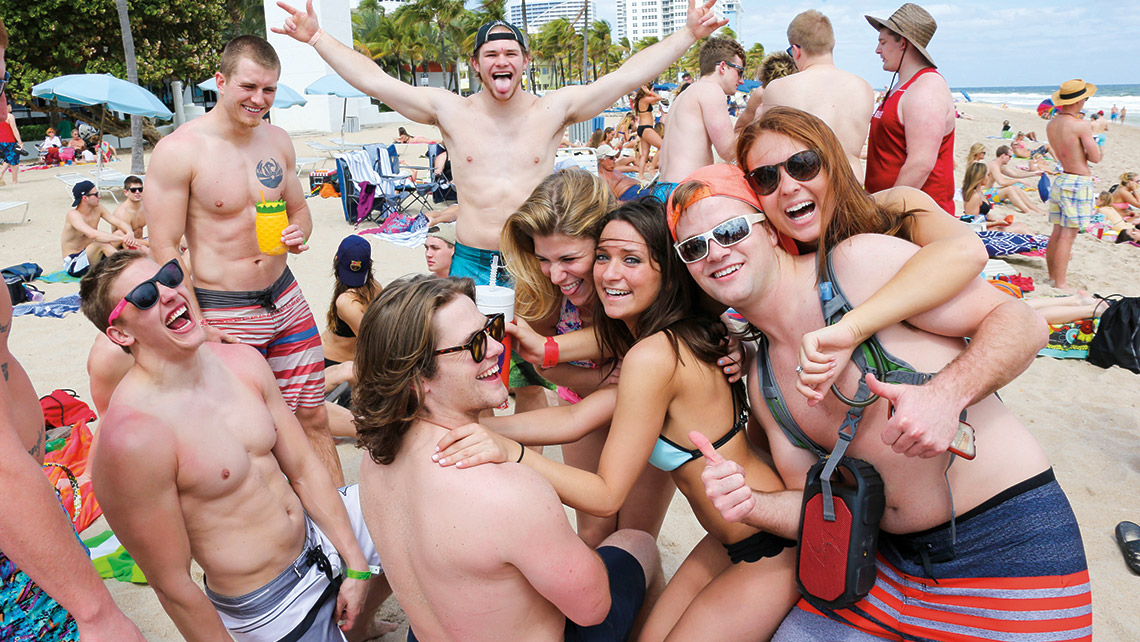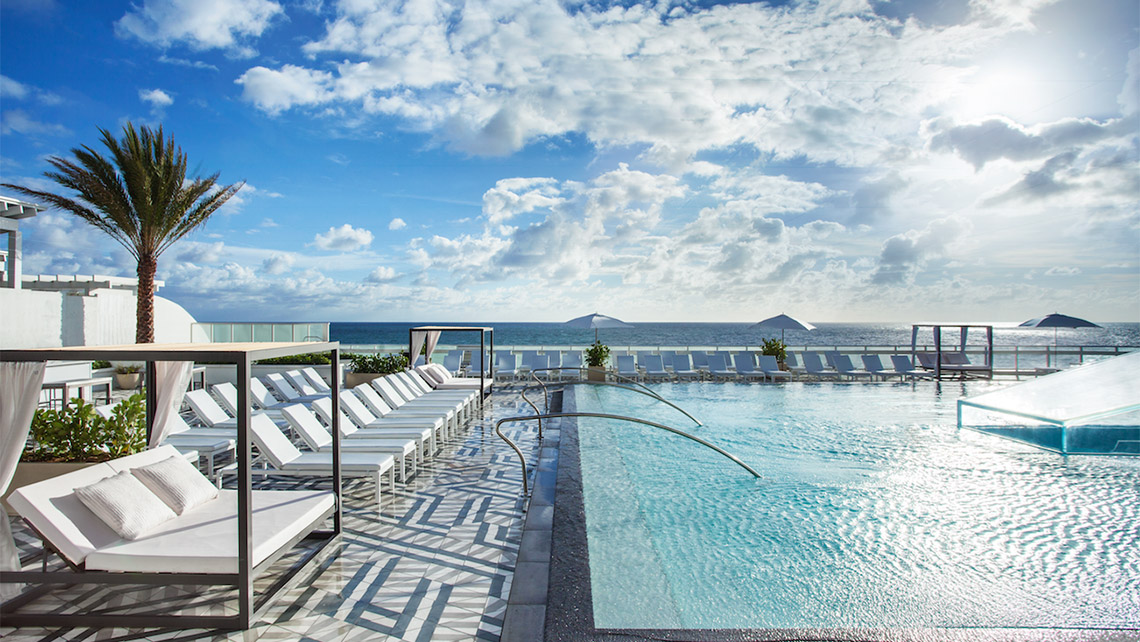Outside Beach Place, the sunburned bros began pummeling one another in a fight circle that grew larger by the second. On the video that made its way to YouTube, it seemed to happen quickly. Two became four. Four became eight. Twelve. Shouting. Right hooks. Headlocks. And then, the crisp sound of a Fort Lauderdale policeman’s whistle. A brown horse marched through the chaos with a mounted officer. Another officer on horseback rode in behind them. With one hand on the reins, the officers swatted past the drunk students, making their way to the epicenter.
Some co-eds raised both hands in defense. Others ran away. The fight disintegrated in a matter of seconds. As the officers trotted away, some spring-breakers simply raised their phones, speechless, and panned their screens to follow the officers as they rode off into the distance. It didn’t take long for a young girl in a coral bikini to start twerking around a Styrofoam cooler and the party was back on again. It was lit.
“There was a particular week—it might’ve been the third week of March—when the beach was quite literally taken over,” says Eduardo Fernandez, general manager of the resort hotel Sonesta Fort Lauderdale Beach, on last year’s spring break scene. “There was a large volume of spring-breakers, there was alcohol brought on the beach and consumption was obvious and blatant and no one made any attempts to hide it.”
It’s difficult to confirm with hard numbers but anecdotally, last spring break was bigger and more rambunctious than previous years. And no one is quite sure whether that’s good or bad. For years, the city has tried to shed its beer-soaked title from the 1980s as the Spring Break Capital of the World. The drinking age went up from 18 to 21, fines were enforced to keep drunk and disorderly conduct to a minimum, and the beach went from hosting 350,000 spring-breakers in 1985 to only 10,000 in 2006. As luxe hotels like the W Fort Lauderdale, Four Seasons and Conrad replace the budget motels catering to the cash-strapped co-eds of yesteryear, city leaders are eyeing their spot as a “year-round world-class destination,” as Mayor Jack Seiler puts it. That’s not to say that the spring-breakers aren’t welcome—the estimated $1,100 each one spends on spring break each year certainly is—so long as they don’t act the part of a stereotypical spring-breaker.
Now, as Fort Lauderdale readies itself for the bacchanalian carnival that’s coming to town again this March, all the usual suspects are tactically planning how to keep the peace. Fort Lauderdale Police confirmed that they will be increasing staffing during spring break with a close eye monitoring underage drinking, public intoxication and open-carry laws. There will be officers on bikes, horseback and foot. There will be narcotic detection canines and traffic enforcement. There will be more garbage and recycling bins and, at night, a beach sweeper will collect any cigarette butts, Solo cups or lone Haviana sandals left behind.
Some leaders also insist that while the students still like to have a good time, this is not a return to the spring break of old.
“Kids are staying at our hotels and they’re not cheap,” says City Commissioner Dean Trantalis, whose District 2 encompasses the city’s famed beachside strip. “They’re not packing 10 kids in a room and spending $200 a week anymore. It’s a different type of customer coming to our beach and there’s a lot more respect for property that we didn’t see in the ’80s.
“Kids come here in their 20s and 30s and that kind of behavior is never going to change, but I don’t want to say that they were out of hand or disrespectful last year,” Trantalis says. “The people coming to visit come from good families and this is the kind of beach atmosphere that we welcome.
“Fort Lauderdale Beach has grown up. The early ’80s was the heyday of spring break but I think today is the heyday of Fort Lauderdale.”
The Party & the Hangover
The 1960 film Where the Boys Are romanticized spring break in Fort Lauderdale as a rite of passage for youths in postwar America. But by the 1980s, the rite of passage had become a civic problem. Everything came to a head in 1985. It didn’t matter that spring-breakers brought in a record $120 million over a six-week period that year; residents, leaders and local businesses had had enough of the traffic, litter and even public defecation.
In late 1985, the city banned open containers. In March 1986, it installed a chain-link fence and barrier to control pedestrians and traffic flow. Arrests had nearly tripled from the previous year. The final nail on the spring break casket came when then-mayor Robert Dressler went on Good Morning America with the mayor of Daytona Beach and told viewers to consider visiting that “fair city” instead. By the 1990s, there were no more of The Button’s infamous “banana-eating contests” (don’t ask) and far fewer wet T-shirt contests or drunken leaps off hotel balconies into the pool.
“Look, I moved to Fort Lauderdale in the ’80s and it was definitely a carnival atmosphere and a lot of unfettered behavior,” Trantalis says. “I think the city fathers back then took a blind eye to [public intoxication] because the beach was economically depressed and they welcomed any influx of cash that outsiders would bring in. But we’re not in that position anymore.”
With spring breakers opting for Cancun, Daytona Beach and Pensacola, the city indeed grew up. Cruise-goers from Port Everglades brought more foot traffic to the A1A strip, while the Fort Lauderdale International Boat Show grew from a big show into one of the world’s premier luxury lifestyle events. New hotels, condos and upscale eateries sprouted up and lured more affluent tourists. Rethinking Fort Lauderdale was a job more than 30 years in the making, says Seiler, but one that now brings in “an estimated 16 million visitors to our area each year who pump more than $14 billion in our local economy.”

But now that Fort Lauderdale seems to have matured, residents aren’t sure if they like what they see. It’s not so much the spring break shenanigans that residents seem to dread the most each March, but the traffic congestion caused by “poor city planning,” says Larry Brunette, president of the beachside Venetian condominiums. “Spring break is just the icing on the cake,” he says.
Burnette was so frustrated by the gridlocked traffic last year that he intentionally planned a trip to Australia to avoid it. “We actually traveled to the other side of the world to get away from spring break,” he says. This March, he’ll be in town and is already dreading the chaos. “I’m sure our nerves will be on edge,” he says. “Every year our fear is that we are going to end up like Miami Beach. Leaving Fort Lauderdale for good might have to be a possibility.”
Traffic woes aside, Catherine Uden of the Broward Chapter of the Surfrider Foundation, a nonprofit environmental group made up of surfers and beach lovers, says the litter that spring-breakers leave behind puts Fort Lauderdale’s environment and marine life at risk. When plastic winds up in the ocean, it degrades into tinier pieces that animals eat and enters our food chain. “Animals are also getting entangled in it,” she says. “When turtles, for example, eat it, they fill up and can’t eat anything else and they starve.”
March also marks the beginning of sea turtle nesting season. It’s crucial for mothers and hatchlings that artificial light is kept to a minimum and that beaches remain clean. Last year, Uden remembers that sea turtle monitors patrolling the northern beach in the early morning stumbled upon heaps of debris from a spring break party held the night before at the Ocean Sky Hotel Resort. “There were Slip N’ Slides and giant plastic sheeting,” Uden says. “It was clear that there was a raging college party and the mess was left overnight.”
Photos posted on social media show crushed cardboard cases of Budweiser, Styrofoam cups, beer bottles, water bottles, beer cans and neon arm bracelets strewn across the sand. The images went viral. “It blew up to the point where even spring-breakers that were at the party were feeling bad and tagging each other,” Uden says. Ultimately, residents, feeling a call to duty, arrived with garbage bags to volunteer and pick up whatever they could. In a few hours, the debris was collected and the negative publicity seemed to have nudged city leaders to act.
“Suddenly temporary bins were everywhere—every 20 feet,” Uden recalls. “I was actually pleased with what I saw: no litter, lots of temporary garbage and recycling bins, and a lot of police presence.”
For the turtles’ sake, Uden hopes it won’t take viral images of garbage to convince the city to increase their police presence to discourage littering and to put up more garbage and recycling bins. “For any big event, the bins seem to always be full and you can’t throw something away even if you tried,” she says. “If you’re drunk, you’re not going to want to walk very far to throw your beer can away, so hopefully the bins are close together again too.”
Spring Break Past and Future
On a recent Saturday afternoon, the Elbo Room – the oldest bar in town and a spring break landmark – embraced an aesthetic from the height of the glory days as sunburned girls in bikini tops and denim shorts danced to a cover band blasting Guns N’ Roses in the back. The floor seems to have remained sticky with stale beer for the past three decades.
“Everything you could imagine happened here,” says Pete Doane, who worked as a bartender at the Elbo Room during the late ’70s, and shakes his head. Now he’s perched on the other side of the bar enjoying a cold one with some friends. “The Button Lounge, Candy Store, Treasure Trove…all up the street was wild.”
But residents, many of whom hold fond memories of those wild, drunken years, do not necessarily want to see a spring break comeback. “In the ’70s, we all jumped in a car and drove down. I used to tell anyone to come to spring break in Fort Lauderdale, that we have a great crowd,” Doane says. “But now the kids got daddy’s credit card. Now I say go to Miami Beach or Daytona because we have enough of ‘em!”
Even the middle-aged bouncer at Elbo Room, who’s propped up on a stool and tasked with carding people who look underage, doesn’t mind the spring break crowd. “Kids aren’t as stupid as they used to be,” he says. “If you do something dumb, everyone will know about it on social media.”
As the sun starts to set and the clouds turn pastel pink and purple, the bouncer nods to himself. “Traffic sucks and I’m almost 50 but what can I say,” he shrugs. “I still love it.”
New Kids on the Block
A crop of new hotels elevates the beach’s spring break scene.
1. W Hotel Fort Lauderdale
Starwood Hotels’ hip luxury W brand has made a mark on Fort Lauderdale Beach with a spot that offers plenty for locals as well as tourists thanks in no small part to the ultra-cool Living Room bar. wfortlauderdalehotel.com
2. Four Seasons Private Residences and Hotel
With the swankiest “porte cochére” on the beach, the Four Seasons Hotel and Private Residences oozes with sophistication. The European midcentury furnishings and polished restaurant overlooking the ocean scream yacht club—not trashy spring break. fort525residences.com
3. The Gale Boutique Hotel and Residences
Attached to its 12-story residential tower, this two-story boutique hotel with 96 rooms brings the sleek, sophisticated interiors of its sister property in Miami Beach to the old Escape hotel, which opened in 1951 with the first swimming pool on the beach. galefll.com
4. Conrad Fort Lauderdale Beach
Opening this past December, this shiny new oceanfront condo/hotel boasts a 20 million-square-foot Sky Deck, rooftop pool, spa, fitness center and seafood restaurant. The lobby’s vaulted ceilings are intentionally modeled after the curves of a luxury yacht. conradhotels3.hilton.com
5. Las Olas Ocean Resort
Conveniently located beside the Bahia Mar Resort & Yachting Center’s mega-yacht marina, Las Olas Ocean Resort is slated to open in summer 2018 with 136 rooms with ocean and bay views and oceanfront pool area on the fifth floor. lasolasoceanresort.com
6. Ritz-Carlton Fort Lauderdale
Not many hotel names say “luxury” like “Ritz-Carlton” does, but the high-end hotel brand’s foray onto Fort Lauderdale Beach also comes with some decidedly Floridian touches. Inspired in part by Prohibition-era rumrunners, hotel restaurant Burlock Coast Seafare & Spirits trades stuffy for sandy. ritzcarlton.com













